Manage Nodes

Warning
Chef Manage is deprecated and no longer under active development. It’s supported on Chef Automate installations up to version 1.8 and replaced by Chef Automate 2.0. Contact your Chef account representative for information about upgrading your system. See our Automate documentation to learn more about Chef Automate 2.
This document is no longer maintained.
Note
Manage
Nodes can be managed from the Chef management console web user interface.
Delete
To delete a node:
Open the Chef management console.
Click Nodes.
Select a node.
Click Delete.
Confirm:
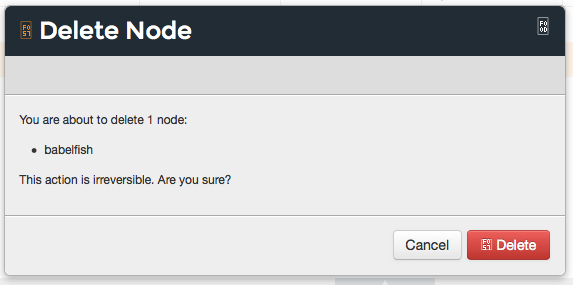
Reset Key
To reset the validation key for a node:
Open the Chef management console.
Click Nodes.
Select a node.
Click Edit Run List.
In the Reset Key dialog box, confirm that the key should be regenerated and click the Regenerate Key button:
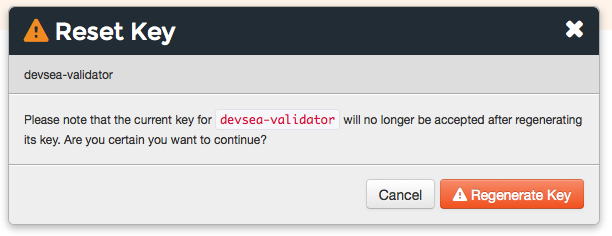
In the Reset Key dialog box, copy the key directly from the dialog box or click the Download button to download the key your local machine:
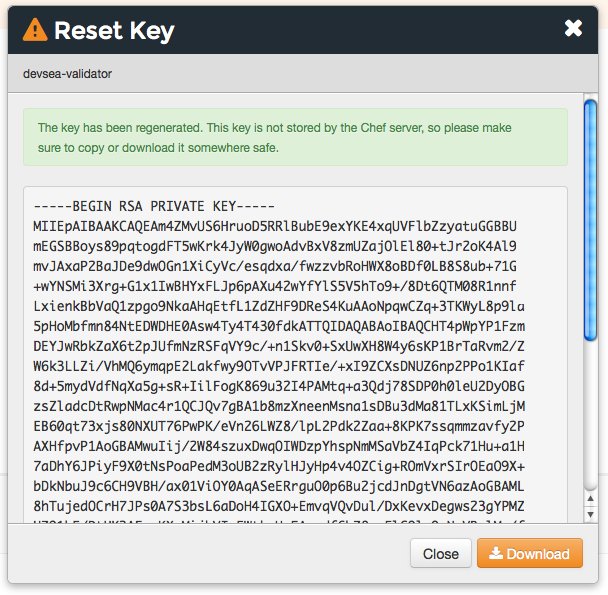
Search
To search nodes:
Open the Chef management console.
Click Nodes.
In the search box in the upper right, enter the search query and click the search icon.

The results will appear in the list below.
Node Attributes
An attribute is a specific detail about a node. Attributes are used by Chef Infra Client to understand:
- The current state of the node
- What the state of the node was at the end of the previous Chef Infra Client run
- What the state of the node should be at the end of the current Chef Infra Client run
Attributes are defined by:
- The node as saved on the Chef Infra Server
- Attributes passed using JSON on the command line
- Cookbooks (in attribute files and/or recipes)
- Policyfiles
During every Chef Infra Client run, Chef Infra Client builds the attribute list using:
- Attributes passed using JSON on the command line
- Data about the node collected by Ohai.
- The node object that was saved to the Chef Infra Server at the end of the previous Chef Infra Client run.
- The rebuilt node object from the current Chef Infra Client run, after it’s updated for changes to cookbooks (attribute files and/or recipes) and/or Policyfiles, and updated for any changes to the state of the node itself.
After the node object is rebuilt, all of the attributes are compared, and then the node is updated based on attribute precedence. At the end of every Chef Infra Client run, the node object that defines the current state of the node is uploaded to the Chef Infra Server so that it can be indexed for search.
Edit Attribute
To edit node attributes:
Open the Chef management console.
Click Nodes.
Select a node.
Click the Attributes tab.
Click Edit.
In the Edit Node Attributes dialog box, make your changes:
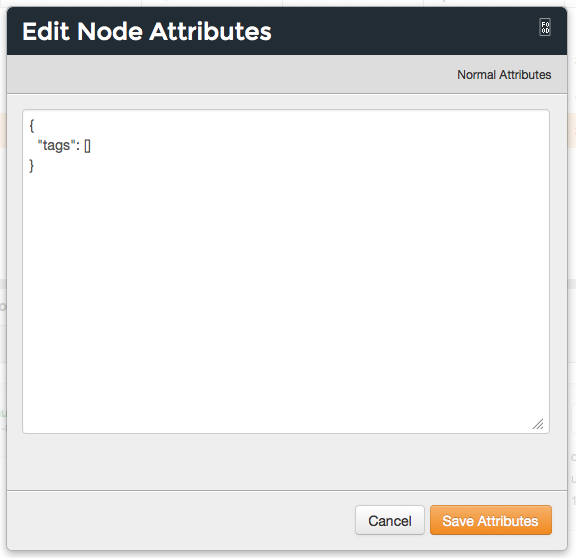
Click Save Attributes.
View Attributes
To view the attributes for a node:
- Open the Chef management console.
- Click Nodes.
- Select a node.
- Click the Attributes tab.
- Click Edit.
Run-lists
A run-list defines all of the information necessary for Chef to configure a node into the desired state. A run-list is:
- An ordered list of roles and/or recipes that are run in the exact order defined in the run-list; if a recipe appears more than once in the run-list, Chef Infra Client won’t run it twice
- Always specific to the node on which it runs; nodes may have a run-list that’s identical to the run-list used by other nodes
- Stored as part of the node object on the Chef server
- Maintained using knife and then uploaded from the workstation to the Chef Infra Server, or maintained using Chef Automate
Add Recipe
To add a role or recipe to a run-list:
Open the Chef management console.
Click Nodes.
Select a node.
Click Edit Run List.
In the Edit Node Run List dialog box, drag the role or recipe from the Available Roles or Available Recipes lists to the current run-list.

Click Save Run List.
Add Role
To add a role or recipe to a run-list:
Open the Chef management console.
Click Nodes.
Select a node.
Click Edit Run List.
In the Edit Node Run List dialog box, drag the role or recipe from the Available Roles or Available Recipes lists to the current run-list.

Click Save Run List.
Edit
To edit a run-list:
- Open the Chef management console.
- Click Nodes.
- Select a node.
- Click Edit Run List.
- In the Edit Node Run List dialog box, make your changes.
- Click Save Run List.
Remove Recipe
To remove a role or recipe from a run-list:
Open the Chef management console.
Click Nodes.
Select a node.
Click Edit Run List.
In the Edit Node Run List dialog box, drag the role or recipe from the Current Run List to the list of available roles or recipes.
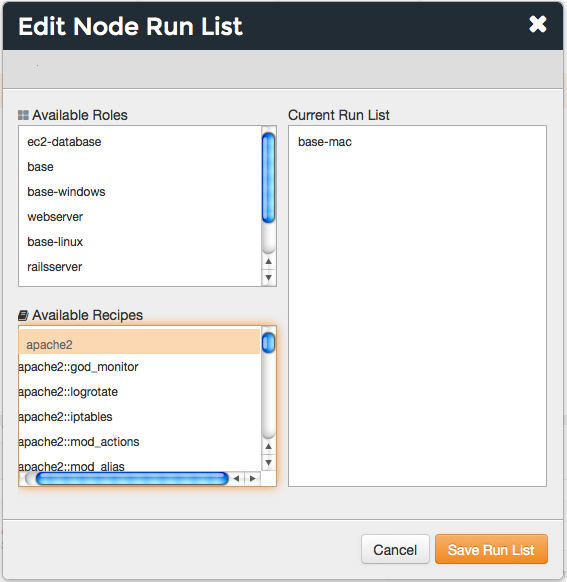
Click Save Run List.
Remove Role
To remove a role or recipe from a run-list:
Open the Chef management console.
Click Nodes.
Select a node.
Click Edit Run List.
In the Edit Node Run List dialog box, drag the role or recipe from the Current Run List to the list of available roles or recipes.

Click Save Run List.
View Current
To view the current run-list for a node:
Open the Chef management console.
Click Nodes.
Select a node.
Click the Details tab.
The current run-list is shown in the lower right:
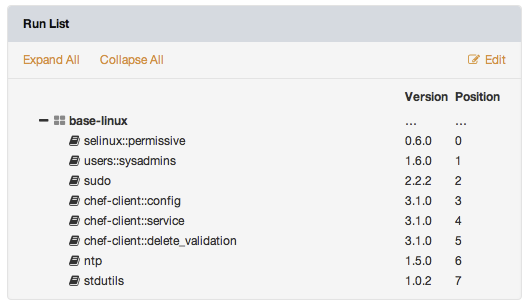
Permissions
Permissions are used in the Chef Infra Server to define how users and groups can interact with objects on the server. Permissions are configured for each organization.Chef Infra Server includes the following object permissions:
| Permission | Description |
|---|---|
| Delete | Use the Delete permission to define which users and groups may delete an object. This permission is required for any user who uses the knife [object] delete [object_name] argument to interact with objects on the Chef Infra Server. |
| Grant | Use the Grant permission to define which users and groups may configure permissions on an object. This permission is required for any user who configures permissions using the Administration tab in the Chef management console. |
| Read | Use the Read permission to define which users and groups may view the details of an object. This permission is required for any user who uses the knife [object] show [object_name] argument to interact with objects on the Chef Infra Server. |
| Update | Use the Update permission to define which users and groups may edit the details of an object. This permission is required for any user who uses the knife [object] edit [object_name] argument to interact with objects on the Chef Infra Server and for any Chef Infra Client to save node data to the Chef Infra Server at the conclusion of a Chef Infra Client run. |
Set
To set permissions list for a node object:
- Open the Chef management console.
- Click Nodes.
- Select a node.
- Click the Permissions tab.
- For each group listed under Name, select or de-select the Read, Update, Delete, and Grant permissions.
Update
To update the permissions list for a node object:
- Open the Chef management console.
- Click Nodes.
- Select a node.
- Click the Permissions tab.
- Click the + Add button and enter the name of the user or group to be added.
- Select or de-select Read, Update, Delete, and Grant to update the permissions list for the user or group.
View
To view permissions for a node:
- Open the Chef management console.
- Click Nodes.
- Select a node.
- Click the Permissions tab.
- Set the appropriate permissions: Delete, Grant, Read, and/or Update.
Manage Tags
A tag is a custom description that’s applied to a node. A tag, once applied, can be helpful when managing nodes using knife or when building recipes by providing alternate methods of grouping similar types of information.Add
To add tags to a node (or a group of nodes):
Open the Chef management console.
Click Nodes.
Select a node (or a group of nodes).
Click Manage Tags.
In the Manage Node Tags dialog box, enter the name of the tag and then select Add Tags from the drop-down.

Click Update Tags.
Delete
To delete tags for a node (or a group of nodes):
Open the Chef management console.
Click Nodes.
Select a node (or a group of nodes).
Click Manage Tags.
In the Manage Node Tags dialog box, enter the name of the tag and then select Delete Tags from the drop-down.

Click Update Tags.
View
To view all of the nodes:
Open the Chef management console.
Click Nodes.
Select a node.
Select the Details tab.
The tags for the node appear under the Tags header:
